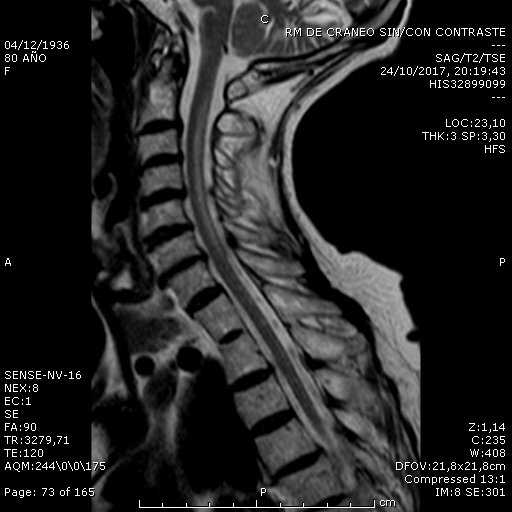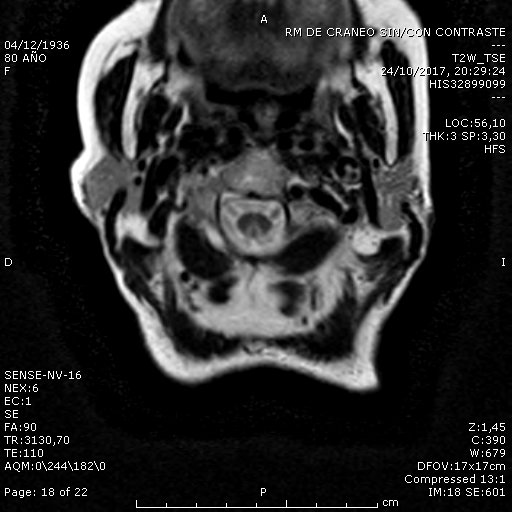Session Information
Date: Sunday, October 7, 2018
Session Title: Choreas (Non-Huntington's Disease)
Session Time: 1:45pm-3:15pm
Location: Hall 3FG
Objective: To describe an exceptional presentation of vitamin B12 deficiency.
Background: Vitamin B12 deficiency typically presents with subacute combined degeneration (SCD). Extrapyramidal symptoms are rare, and only six cases of chorea have been reported so far, none of them in association with SCD.
Methods: Case report.
Results: An eighty-year-old woman with medical history of hypertension and dyslipidemia presented with acute onset of confusion, behavioral disturbances and involuntary generalized hyperkinetic movements. On examination, generalized choreiform movements were noted. In addition, she presented generalized proprioceptive hypoesthesia and wide based gate ataxia, being unable to walk unaided. Muscle strength was normal, the stretch reflexes were abolished and Romberg´s sign was present. She was inattentive but without cognitive disturbances. Laboratory tests showed severe pancytopenia (hemoglobin 7,4 g/dL, leucocyte count 2,06 x10^3/µl, platelets 114 x10^3/µl), with macrocytosis (MCV 115 fl) and elevated hemolysis parameters. Vitamin B12 level was undetectable (lower detectable range 83 pg/mL, reference range: 180-914 pg/mL) and serum folate was normal. Peripheral smear showed hypersegmented neutrophils suggestive of pernicious anemia. Antiparietal cell antibodies were positive at 1/160 and an upper gastrointestinal endoscopy disclosed atrophic pangastritis. Thyroid function was normal and no other autoimmune diseases were found. Cervical MRI showed bilateral and symmetric T2 hyperintensities of both posterior cords from C2 to C6-C7 [Figure 1 & 2]. Two units of packed red blood cells were transfused and a course of intramuscular cyanocobalamin scheduled (1000 mcg daily for 10 days followed by 1000 mcg weekly for 6 months, and monthly thereafter) along with folic acid (5mg every day). Clinical symptoms and laboratory findings improved dramatically, and the patient was discharged with mild chorea involving only the fingers and mild ataxia after two weeks, being asymptomatic at 5 months follow up.
Conclusions: Chorea is a rare manifestation of vitamin B12 deficiency. The striking reversibility of neurological symptoms with substitutive treatment supports the pathogenic role in our case. As a treatable disorder, it must be ruled out in any patient with chorea of unknown etiology, especially when more typical manifestations (as SCD and hematologic abnormalities) concur.
References: De Souza A, Moloi MW. Involuntary movements due to vitamin B12 deficiency. Neurol Res. 2014; 36(12): 1121-8. Edvardsson B, Persson S. Chorea associated with vitamin B12 deficiency. Eur J Neurol. 2011; 18(10): 138-9.
To cite this abstract in AMA style:
E. Natera, F. Acebrón, A. Sánchez, V. Ros, A. Gómez, F. Ruiz, B. Zarza, C. Estévez, A. Alonso, JC. Martínez-Castrillo, I. Corral. Acute concomitant presentation of chorea and subacute combined degeneration secondary to vitamin B12 deficiency [abstract]. Mov Disord. 2018; 33 (suppl 2). https://www.mdsabstracts.org/abstract/acute-concomitant-presentation-of-chorea-and-subacute-combined-degeneration-secondary-to-vitamin-b12-deficiency/. Accessed April 20, 2025.« Back to 2018 International Congress
MDS Abstracts - https://www.mdsabstracts.org/abstract/acute-concomitant-presentation-of-chorea-and-subacute-combined-degeneration-secondary-to-vitamin-b12-deficiency/


